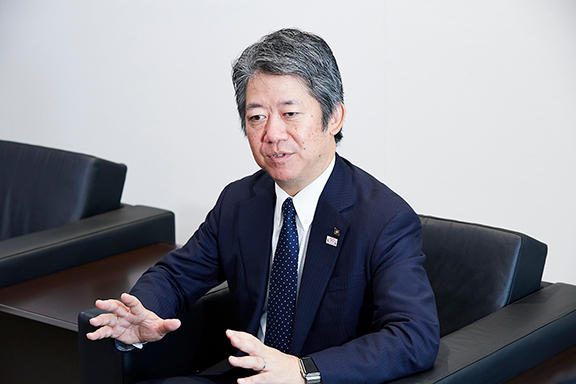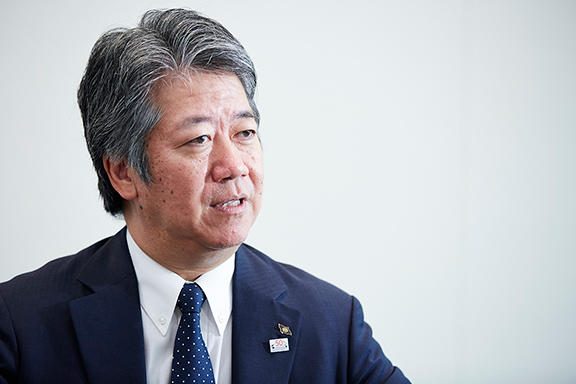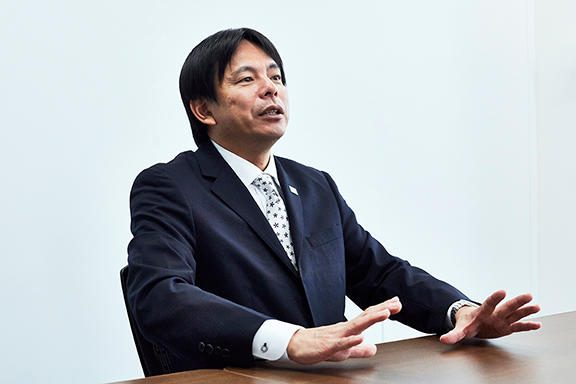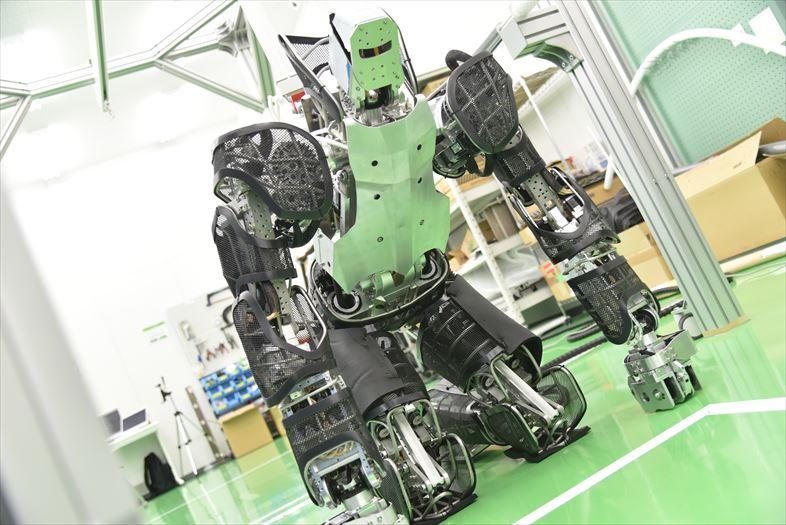It is an open platform, so anyone can take on the challenge of robot development if they have the initiative.
Where there are smartphones, there are applications. With Apple and Google having made their app stores available to the general public, engineers and third-party vendors from all over the world have entered the race of developing smartphone apps. There was even a term, “app millionaire”, to describe the people who can earn millions by sales of apps entirely based on the quality of their apps, without the knowledge of hardware design.
These apps make the smartphones as the platform more attractive, generating an increase in the number of smartphone users, which in turn increases the number of people using the apps. What an amazing upward spiral.
This spiral is happening outside of the smartphone industry. Other industries are seeing the tide of open platform systems propelling the current era as well. One of the companies heading such front is Kawasaki Heavy Industries, or Kawasaki. For 121 years, Kawasaki has continued to produce products that have brought a tremendous impact in society throughout the generations including motorcycles, bullet trains, and the manned research submersible DSV Shinkai among others. Little known, in fact, is that Kawasaki is also a robot manufacturer that has worked on the development and manufacture of industrial robots for the last 50 years.
Through its open innovation, Kawasaki plans to promote the development of open-platform humanoid (human-shaped) robots.
The humanoid robots that were on display at the Kawasaki booth at the International Robot Exhibition (iRex) 2017 held from November 29 through December 2 were powerful enough to carry loads of over 60 kg (around 132 lbs.) and can perform pull-ups, all while being kept human-sized. There were also models that wore clothes, possibly hinting at a day when robots and humans can stand and work together.
So what is Kawasaki, which has already built up a steady share of the industrial robot market, aiming to achieve by venturing into humanoid robots? Let’s interview the key persons at Kawasaki to find out more.
Kawasaki aiming to transform from an industrial robot manufacturer to a fully integrated robot manufacturer
2017 has been a year of big changes in the robot market in Japan with SoftBank purchasing robot manufacturer Boston Dynamics, Sony releasing a new AIBO robot model, and Honda starting to bring back its ASIMO robot team. What was the purpose driving Kawasaki to begin development on humanoid robots?
To get the answer, the first key interviewee at Kawasaki was Mr. Yasuhiko Hashimoto, the Managing Executive Officer and General Manager of the Robot Division as well as the deputy director of the Japan Robot Association.

Yasuhiko Hashimoto: Kawasaki’s effort into humanoid robots comes from our theme that “first, we should work together to make the market bigger.” For example, a shopping mall, where many stores are all in one place, can attract more people than a single store. We are aiming to be this shopping mall. We believe that the robot industry has a large market potential, a shopping mall where the parking lot is full every day.
At present, Kawasaki deals with a variety of different industrial robots. There are robots not only for use in factories but also robots used to assist with medical treatment, and we have also started development of humanoid robots. The core of our company is the trust of our customers cultivated through our industrial robots. Our customers can use our robots for a long time without worry and should problems arise, we have a support solid system in place that enables us to quickly go out and provide customer assistance, guaranteeing our robots throughout their lifetime. I hear people say, “Robots are still dangerous to have around and you have to place them inside safety fences and because of that, we cannot use them at our company.” It is because of this attitude that we are wanting to change from being an industrial robot manufacturer to a fully integrated robot manufacturer,so that we can create robots that are safe enough to sit next to humans.

――If there are robots out freely at home and on the street that can naturally coexist with people, it will inspire a lot of dreams, won’t it?
Hashimoto: As robots expand into society, we think it is important to give form to the part through which humans make judgements intuitively.
The current humanoid robots are designed to give “tough” impression. If they were humans, they are stocky built, can carry heavy objects, and can survive just fine if kicked or knocked over. They have sturdy-looking outer appearances, but also a menacing quality to them, and there is probably no demand for this type of robot in regular households. We are also thinking of creating more compact, slim-bodied robots with gentler appearances. One of our ultimate goals is to create robots that humans feel comfortable around them.
As for why we chose to go with a humanoid form, this is because they will need to work in societies where humans live.They are made to match human sizes, human strength, and the range of movements of humans in a variety of environments throughout the world where humans live and work, such as the height of stairs, the weight of door knobs, the size of cardboard boxes, and so on.
Mr. Hashimoto believes that the outer appearance of robots needs to of course be changed to match the situation in which they are used. If robots that are small and cute are used in areas of natural disaster, it may make people feel uneasy about the ability of the robot to do the work. Using robots with a more reliable-looking form in such areas will give people a greater sense of security.
A platform that can be customized to match any need
Kawasaki is aiming to make robots that can naturally blend into any space without making people uncomfortable, but what are the specific characteristics of such a robot? Next key person from Kawasaki to talk to is Mr. Tomonori Sanada, the Department Manager of the Marketing and Business Planning Department of the Robot Division at Kawasaki.

Tomonori Sanada: The greatest characteristic is an open platform robot. Kawasaki is not going to develop all the different parts just by ourselves. We are instead taking an approach in which we provide a base model to partners and try various things together.
――Up until now, there has not yet been any record of a humanoid robot made by an industrial robot manufacturer. Rather, it seems that conceptual models or exhibition models used for technological development are more common.
Sanada: The focus of development tends to be how close humanoid robots can resemble or exceed humans, such as walking and artificial intelligence (AI). In this regard, many researches are being conducted in academia and by business ventures on various types of cutting-edge technology. However, there have not been any robot models that can be equipped with the leading-edge features developed from these researches. That is why we here at Kawasaki, as a robot manufacturer and as a manufacturer of heavy equipment, have now decided to create a tough robot body that does not easily get damaged. By making an open interface, we want to provide a base machine model to various individuals and groups for them to test all sorts of researches on, both conventional and unconventional.
If different people can conduct a research using the same robot, we can pull together all the information and data that is collected, such as the data on the cause of mechanical troubles, the robot’s advantages, and their weaknesses. We can then incorporate that information into updating the robot and create a new, improved next-generation model. We imagine that doing so will produce a sort of friendly competitive spirit, if you will, a type of synergetic effect that will contribute to the evolution of the robot without any wasted effort on the part of the participants.
Our focus is to make robust robot bodies, which is our specialty, and our development objective now is to make robots more closely resemble to humans.
Using technology produced by partnered engineers to improve quality even further. By gathering a great deal of knowledge, we can allow greater customization using improved parts. This will lead to further evolution of the base model. It almost resembles the world of motorcycle racing.
Points we must consider as an industrial robot manufacturer

Sanada: With the humanoid robots made so far, efforts in reproducing human movement, the most struggling part of the development, comes first. The ease of repair and parts replacement has been considered secondary. Problems then arise when the exoskeleton used as the robot’s frame bends suddenly because spare parts are not ready.
Kawasaki decided to use an internal skeleton. We also use field-proven parts that are about the same as those used in our industrial robots instead of using anything proprietary as components for each part. These parts are guaranteed for around 100,000 hours of use based on mean time between failures (MTBF). They are highly reliable parts that break only once in every few decades or so but are also lower in cost because they are manufactured in large quantities. They can also be obtained at a moment’s notice. The robots can thus be repaired almost immediately should they break down, and the components can be treated as disposable should the user decide on that route.
For example, if a volcano erupts, volcanic bombs will be ejected, and the ground temperature will rise to several hundred degrees due to the radiant heat from the molten lava. Humans cannot immediately engage in rescue activities because of the heat, so they have to wait until the ground has cooled down enough. But robots built to withstand heat can move into such areas and start rescue efforts immediately. They are machines that can be expected to perform in such environments and if they melt in the end, then so be it. There was a scene at the end of the movie The Terminator in which the robot says, “I’ll be back” before walking into a furnace of its own will and sinking to the bottom. Such acts will become possible with these advancements.
――One of the models that is currently under development was around 173 cm (around 68 in. or 5 ft. 8 in.) in size. It weighed less than 100 kg (about 200.5 lbs.). That is about the same size as a full-grown adult man. It was so surprising to find it was so much lighter than I had imagined!
Sanada: If we use a robot that is 50 cm tall (just under 20 in.) and ask it to push a certain button or pull a certain doorknob open, it wouldn’t be able to reach either object, right? It would be too lightweight and get pushed over by the recoil of the button it tried to push or get pulled up if it tried to pull the lever. On the other hand, if we try to build one that is as robust as a piece of construction equipment, we will end up with a robot that weighs several tons. If a robot that heavy tries to go up into a building or up a set of stairs at risk of collapsing due to damage from a natural disaster, the robot itself could cause the building or stairs to collapse.
It is for this reason that we set our goal to establish robots that can operate in the environment designed for humans. We recognize the importance of making robots with the size and weight around that of a brawny adult.
Future where robot engineers’ expertise comes together at Kawasaki

What Kawasaki is working to create can be described as a regulation. By providing a base model that can serve as an industry standard, anyone who wants to participate in robot development can give it a try, and methods for making robots made to reference specifications (based on samples taken from development and actual use), such as the weight of the robot body and strength of the motor used, that move efficiently will be devised.
From the comments from Mr. Hashimoto and Mr. Sanada, we can picture future where leading engineers bring their expertise together to make humanoid actually work in our society.
For example, if a battery has been optimized for the weight of the robot body and the torque of the motor, it would allow operation for several hours even with the power cable unplugged. In addition, if we make heat-resistant jackets that fit the size of the robot, we can even more readily send it out to perform rescue operations in actual times of volcanic eruptions. If the robot has the same size as a human, it might even be able to operate heavy machinery that has been left on sites of natural disaster. The possibilities seem endless.
If a number of engineers participate in the research, we can accumulate data from the results of a greater number of challenges. Depending on the circumstances, we might even be able to consider offering the technology produced through channels provided by Kawasaki. It means that the robot open platform can function like a store as another feature.
In order to pursue the goal of creating a robot that will actually become part of society, an environment in which a great number of developers can participate and help in needs to be created and not one in which all steps are solely completed. The day in which a robot with the KAWASAKI emblem stands next to us may one day come.
Photography: Kazuya Sasaka (Interview), Ryota Musha (Robots)
Text:Musha Ryota
Read the original article on GIZMODO JAPAN 11.22.2017 * Available in Japanese.